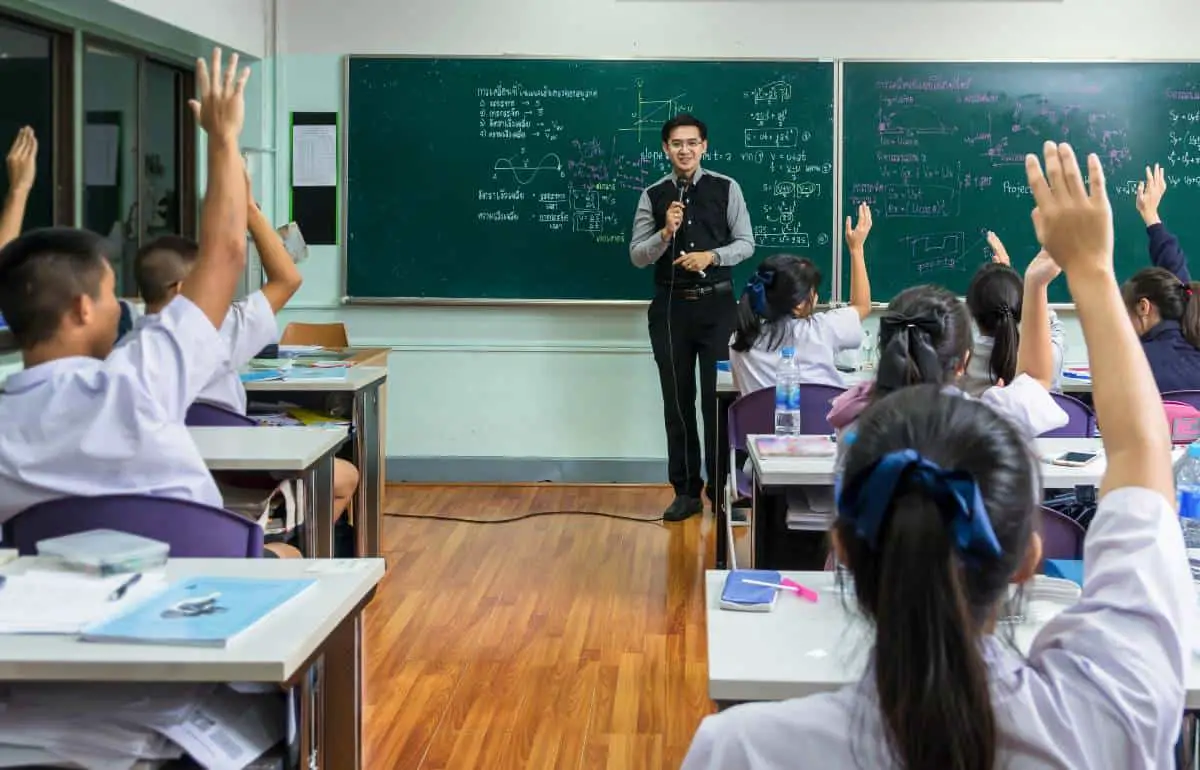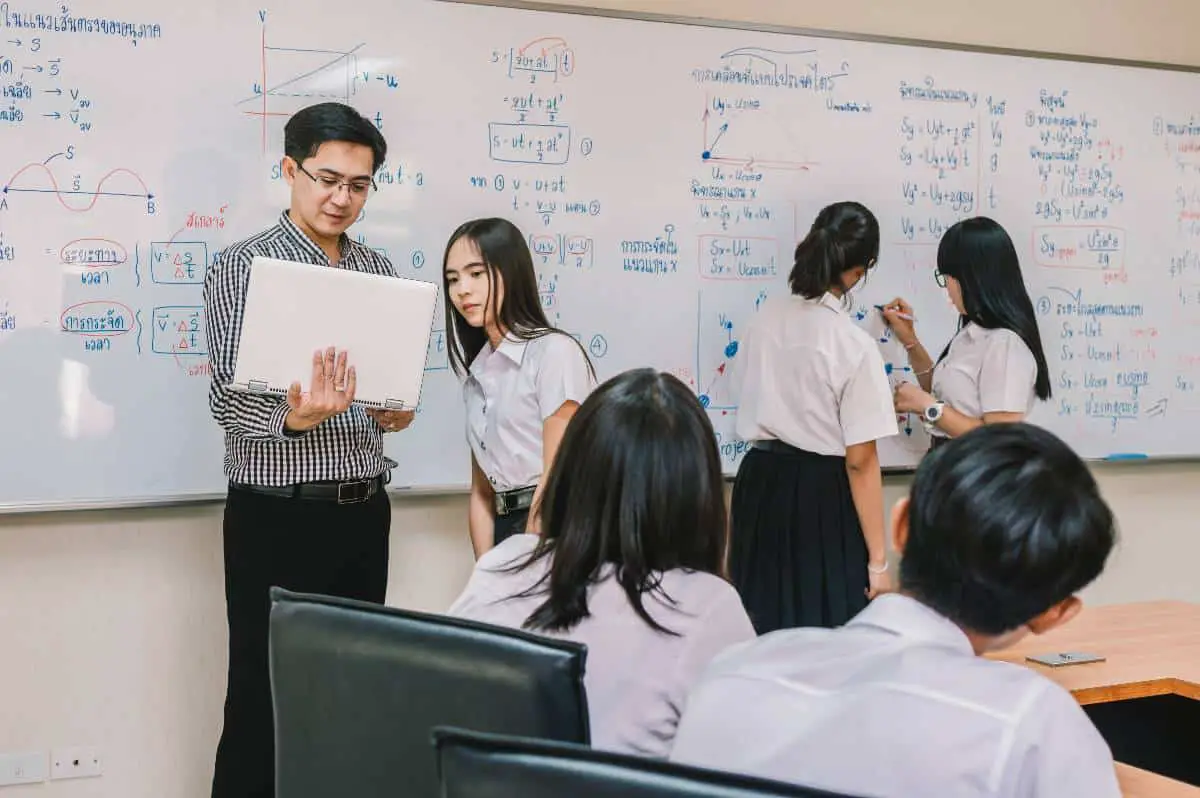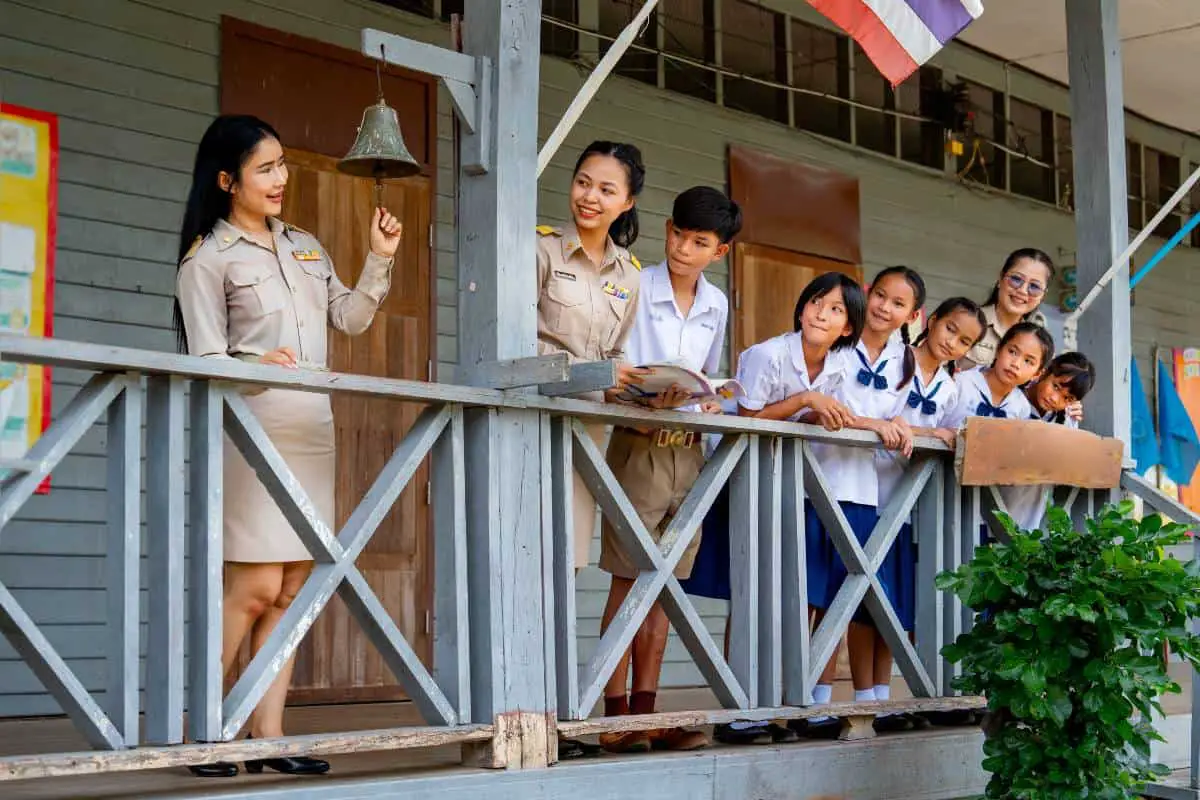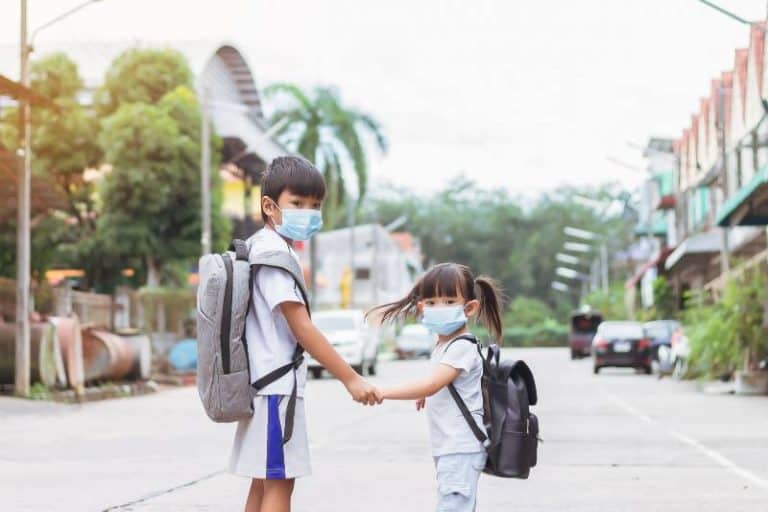Exploring The Education Culture In Thailand
As an expat living in Thailand for over a decade now, I’ve had the chance to learn about and experience the local education culture firsthand through my two children. Education holds an important place in Thai society, with high expectations placed on academic achievement. Blending traditional Eastern values with modern Western curriculum has been an evolving challenge for Thailand as it aims to prepare youth for competing in a 21st-century global landscape.
Key Takeaways
- Thailand’s education system blends traditional cultural values with modern curriculum and pedagogy. Issues like rote learning and exam pressure persist.
- Increasing demand for degrees has led to growth in higher education, though rural access and teacher shortages challenge the system.
- Reforms aim to improve quality and integrate tech while preserving heritage. Parents highly value education success.
Educational Culture in Thailand
Ministry of Education
The Ministry of Education oversees all public schools and policies in Thailand. It sets the national curriculum and learning standards that guide instruction across core subjects. For example, in 2008 it instituted the Basic Education Core Curriculum as a framework.
Compulsory Education
Education is free and required for all Thai children ages 6-15 or at least 9 years. This includes 6 years of primary education and 3 years of lower secondary education.
For example, you’ll see uniform-clad students riding bikes or public transit to get to school during these years.
Primary Education
The 6 years of primary school in Thailand are called Prathom 1-6. Kids ages 6-11 attend primary school, similar to elementary school in Western nations.
The classroom environment shifts from play-based learning in the early primary to more lecture-based by the later years. Students get a basic foundation in subjects like Thai language, English, and math.
Secondary Education
Secondary education is divided into lower and upper levels. Lower secondary lasts 3 years known as Mathayom 1-3 for ages 12-14. Students take core courses and can choose some electives too.
Upper secondary see even more subject specialization in math, science, arts, etc. based on student’s skills and interests.
Core Subjects
Subjects like Thai, math, and science form the core foundation of study as mandated by the national curriculum. English is also compulsory, while social studies and physical education add to well-rounded development. Students can later take electives like arts, music, etc.

How Does Enrollment Work in Thai Schools?
Foreign Language Education
In public schools, English is the main foreign language taught from primary years onwards to build communication capacity. Private schools, especially international ones, offer additional language options such as Chinese, Korean, Spanish, etc. tailored based on different curricula.
Vocational Education
Thailand offers vocational study streams to secondary school students focused on practical career skills in fields like agriculture, manufacturing, and services. This provides an alternative pathway to direct job placement or specialized post-secondary diplomas.
For example, students can take 2-3 year diploma programs in IT, business, design, etc. at technical and vocational colleges.
International Students
Many public and private schools in Thailand welcome the enrollment of foreign students and expat children. International curriculums in subjects like IB or AP are options at some larger private schools in metro areas.
Specialized Thai language crash courses help foreign students pick up the instruction medium.
Are There Specific Features of Thai Education?
Thai Language and Culture
Classes in Thai language, history, and culture are embedded in core curriculums to solidify national identity and heritage. This includes Thai literature, poems, folk stories, ethics and values. Students may take field trips to historic sites.
For example, all Thai kids read the story of the legendary King Naresuan. They sing the national anthem daily to instill patriotism.
Education and Training
Applied learning via internships, apprenticeships, and vocational training provides practical industry exposures to secondary and post-secondary students in both workplace and simulated contexts.
For example, hospitality students run culinary stalls, nursing trainees work shifts in clinics.
Arts and Music Education
The role of arts and music is valued for fostering creativity, expression, and harmony. Students pick up instruments like the recorder, ukulele, or traditional Thai ones. Art electives teach crafts and visual media.
For instance, daily broadcasts lead group music sessions. Students collectively create large art installations showcased publicly.
Physical Education
Exercise and fitness form a central habit cultivated from a young age via mandatory PE classes. Weekly activities like mass aerobics, sports tournaments, and field day events lead to healthy, athletic bodies.
As an example, annual inter-school sports meets feature relay races and traditional Thai boat rowing paired with musical cheer squads rooting friends on.

What Influence Does the Education Commission Have on Thai Education?
Thailand Education Commission
The Ministry instituted the Education Commission to spearhead improvement initiatives like decentralization, quality benchmarks, ICT upgrades, and learning assessments. For instance, the Commission modernized classroom teaching-learning with computers, projectors, and other technologies.
Education Institutions in Thailand
Overseen by the Commission, the number of schools at K-12 levels has multiplied over decades to expand nationwide access. Recent years saw the growth of international schools and universities catering to rising middle-class demand for globalized education. Special needs, vocational, and non-formal schools add options.
Number of Thai Students in Education
Thanks to heavy investment in education infrastructure, the number of Thais enrolled has hit record highs. 2021 saw 11 million students at primary and secondary levels and beyond – around 40% of the population. Targets aim for 60% of youth entering higher education by 2030.
Educational Reform in Thailand
The Commission introduced major reforms like decentralization to give localities more autonomy over budgets, administration, and curricula. Customization addresses community needs and resources. Furthermore, the supply of qualified teachers still lags behind the swelling demand.
Demand for High-Quality Education
With Thai economic and societal advancement, demand has risen for schools meeting international standards. Many urban parents thus opt for private schools or specialized academies reputed to ready students for global universities, equipped with high-tech facilities and holistic programs from top faculty.
What are the Challenges Faced by the Thai Education System?
Rapidly Aging Education System
Thailand must urgently expand and upgrade dated infrastructure in many rural public schools towards smarter facilities to equally prepare youth for the digital economy and to achieve the United Nations Sustainable Development Goals.
Integration with International Education Standards
Transitioning teaching methods towards participative applied learning that engages creativity and critical analysis rather than mechanistic rote memorization poses another challenge as Thailand balances Western approaches with Eastern cultural values.
Educational Disparities in Thailand
Stark divisions in opportunity and outcomes exist between well-funded elite urban schools and remote, neglected ones grappling with teacher shortages, limited budgets, and minimal facilities. Closing gender, income, and regional gaps align with equitable quality education principles.
Efforts for Improving Academic Performance
To enhance youth academic performance as local and international assessments indicated shortfalls, Thailand updated curriculums to align with 21st-century skills. Schools now better integrate technology, English proficiency, cognitive-social capacities like public speaking, and project teamwork hitherto underemphasized.
Equal Access to Education in Thailand
Goals are underway to foster inclusivity such that location, disability, or legal status no longer limit enrollment. For example, disadvantaged groups like refugees, migrant kids, and teen moms are supported via MoE partnerships with NGOs providing transport, scholarships, and alternative delivery modes to guarantee education as a human right.
Primary and Secondary Education
In Thailand, education is compulsory for children ages 6-15. The school system is based on 6 years of primary education, followed by 6 years of secondary:
- Primary: Prathoms 1-6, ages 6-11
- Lower Secondary: Mathayoms 1-3, ages 12-14
- Upper Secondary School: Mathayoms 4-6, ages 15-17
Most public schools follow Thailand’s national curriculum set by the Ministry of Education. Private schools, including a growing number of international schools, offer alternative curricula like the International Baccalaureate.
While rote memorization and rigidity still characterize some classrooms, modern reforms aim to develop critical thinking and collaboration:
- Emphasis on participation, projects, public speaking
- Technology integration via computers, media, and smart devices
- Course electives like arts, sports, and foreign languages
Higher Education
In pace with Thailand’s development, demand for colleges and universities has rapidly increased:
- Over 150 public and private universities across Thailand
- Degrees in business, engineering, and tourism popular
- Many joint programs or partnerships with foreign universities
Yet credential inflation makes securing rewarding careers competitive, compelling many to pursue graduate studies domestically or overseas.
Educational Challenges
Amid progress, Thai education still grapples with issues of uneven quality, access inequity, and blending tradition with innovation:
- Rural schools suffer poor infrastructure, teacher shortage
- Societal customs like seniority and hierarchy ingrained
- Exam-based system instills intense pressure to perform
Reforms look to elevate standards while customizing curricula across communities.
Reforming the System
To enrich quality and align skills with economic needs, Thailand has implemented policies via agencies like the Education Ministry and Private Education Commission:
- Teacher training and merit-based pay incentives
- DEC – Digital Economy Curriculum to Boost Competitiveness
- STEM focus consistent with global trends
- School-based management for localized solutions
Blending Traditional Values and 21st Century Skills
Thai culture emphasizes respect, discipline, and communal bonds. As the education landscape modernizes, balancing heritage and global integration is key:
- Maintaining cultural identity amid a globalized curriculum
- Communal values like gratitude and humility are still prized
- Fusing English fluency with the preservation of Thai language
Parental Perceptions and Investment
Thai parents take an active role in supporting their children’s mastery and academic rise:
- Meritocratic beliefs in education pathways to mobility
- Shadow education through intensive tutoring common
- Strong societal pressures to achieve scholastic success
While this parental involvement fosters learning, it risks burnout without leisure.
Future Outlook
As Thailand progresses towards advanced status guided by Thailand 4.0 initiatives, its education ecosystem must synchronize with sustainable development goals. Priorities like inclusive tech and individualized instruction will help realize an innovative society powered by creative pluralism.
FAQs
What are some cultural issues Thailand faces regarding education?
Key pressure points include exam stress, rote learning tendencies, uneven quality in rural zones, blending traditional Eastern and modern Western values, and high parental involvement.
How is Thailand reforming its education system?
Major initiatives aim to spread quality instruction to all communities, improve teacher training, integrate technology, teach 21st-century skills like critical thinking while retaining cultural heritage, and customize curricula using school-based management.
What are popular degrees and higher education options?
Rising demand for tertiary studies has increased the uptake of degrees in fields like business, engineering, tourism, and hospitality in Thailand’s many public and private universities, along with overseas universities.
How are parents involved in education?
Thai parents closely support their children’s studies via widespread shadow education through extra classes and tutors. Meritocratic beliefs prevail about education enabling mobility.
What is the future outlook for Thai education?
Thai education aims to balance innovation with cultural identity by fusing high-tech systems, creative thinking, and egalitarian accessibility while retaining heritage values as part of sustainable, student-centric development.
Conclusion
I hope this article provided helpful insights into Thailand’s vibrant education landscape – the commendable expansion undertaken alongside the constant balancing act in fusing innovation with cultural wisdom. Quality instruction ultimately uplifts individual horizons while fueling national growth.
As an insider guiding foreigners in unlocking life in Asia, I’m happy to advise you on finding the optimal school fit for your child’s needs. Please subscribe for more hyperlocal perspectives. And feel free to contact me if you need assistance settling your family abroad as expats.
Wishing you and your little ones success in charting new cross-cultural learning journeys amid Thailand’s welcoming society!






